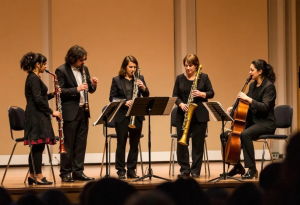Mozart. Just the name makes you think of powdered wigs and fancy concert halls, right? But forget the image for a second. Let’s talk about the music itself – his chamber music, to be exact. It’s not just notes; it’s a conversation. Instruments chatting, arguing, sharing. And it’s a legacy that still gets us going today.
Forget Background Music: This is Mozart’s Chamber Magic
Okay, some classical music can feel, well… a bit much. But Mozart’s chamber music? It’s anything but boring. Think of it as a jam session with your best mates, each with something unique to say. String quartets, piano trios, sonatas – they’re not just pretty sounds. They’re mini-dramas, full of wit, passion, and surprises. Those six string quartets dedicated to Haydn? Game-changers. They didn’t just follow the rules; they made new ones.
Risk-Taker: Mozart Breaking the Rules
So, what made Mozart stand out? Simple. He wasn’t scared to try new things. He took risks with harmony, structure, and even rhythm. It wasn’t just about catchy tunes (though he had plenty!). It’s how he used them. He’d weave them together, bounce them off each other, build tension, then release it. Check out his piano trios. The way he flips the mood, sometimes in just a few bars, is mind-blowing. It’s like he’s painting a sound picture, and you’re right there, feeling everything.

More Than Notes: The Gut Punch
Alright, enough with the technical stuff. Let’s talk feelings. Mozart’s music isn’t just smart; it hits you hard. His melodies stick with you, tapping into something deep down. Whether it’s the pure joy of a string quartet or the soft touch of a piano sonata, his music speaks to what it means to be human. And that’s why it still gets to us today.
Why Mozart Still Rocks
Mozart wasn’t just writing tunes. He was shaping the future of music. He took what the Baroque guys started and built something new. Something that paved the way for Beethoven, Brahms, and tons of others. He proved chamber music could be more than just something pretty to listen to. It could be a way to express deep artistic ideas.
Keeping the Flame Alive
So, how do we keep Mozart’s music alive? Easy: Listen! Dive into his chamber music. Go to a concert. Chat about it with your friends. And if you play music, let him inspire you. His music reminds us that real innovation comes from mixing skill with real emotion.
Mozart: The Gift That Never Stops Giving
Musicians and composers keep digging into Mozart’s work and finding endless inspiration. His knack for mixing technical skill with beauty sets the bar high for chamber music. By protecting and growing his legacy, we keep the conversation going between the past and the present. Ensuring Mozart’s music stays relevant forever.
Digging Deeper: Beyond the Basics of Mozart’s Chamber Music
We’ve covered the basics, but Mozart’s chamber music is a vast ocean to explore. It’s not just about the melodies, but the intricate relationships between the instruments. Think of it as a sophisticated conversation where each instrument has its own personality and viewpoint. This interplay is especially evident in his string quintets, where the addition of a second viola adds a richer, darker texture to the ensemble. These works are often considered to be among his most profound and emotionally complex.
The Influence of Patronage and Personal Life
It’s easy to forget that Mozart, despite his genius, was a working musician who depended on the patronage of wealthy individuals and institutions. His chamber music was often written for specific occasions or to please particular patrons. This context can shed light on some of the stylistic choices he made. For instance, some of his lighter, more entertaining works were likely intended for social gatherings, while his more serious compositions were reserved for more formal settings. His personal life, including his struggles with finances and his complex relationships with his family, also influenced his music, adding layers of depth and emotion to his compositions.
The Evolution of Chamber Music Form
Mozart didn’t invent chamber music, but he certainly revolutionized it. He took the established forms of the Baroque era and infused them with his own unique style, characterized by elegant melodies, sophisticated harmonies, and a keen sense of drama. He also expanded the possibilities of chamber music by experimenting with different instrumental combinations and pushing the boundaries of musical expression. His work paved the way for the Romantic composers of the 19th century, who further explored the emotional and expressive potential of chamber music.
Mozart’s Chamber Music: A Gateway to Understanding
Mozart’s chamber music serves as a fantastic entry point to understanding the broader world of classical music. It’s intimate, accessible, and filled with instantly appealing melodies. By exploring his chamber works, listeners can develop an appreciation for the intricacies of musical form, harmony, and counterpoint. It’s a rewarding journey of discovery that can lead to a lifelong love of classical music.
Frequently Asked Questions (Because You’re Curious)
- What’s so special about Mozart’s chamber music? It’s a crazy mix of new ideas, beauty, and deep feelings.
- How did Mozart influence other composers? He showed them a new way to express themselves through music.
- Why do we still listen to Mozart? Because it’s timeless, brilliant, and touches your soul.
- What are some must-hear Mozart chamber works? Check out the “Dissonance” Quartet, the “Hunt” Quartet, and his piano trios in G major and D minor. Trust me, you’ll love them.
The Last Word
Mozart’s chamber music is more than just old songs. It’s alive. It’s a testament to how music can move us, inspire us, and connect us. It’s a conversation that started ages ago and keeps going today. And by listening, playing, and studying his work, we can all join in.

